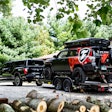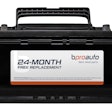Renewable Dairy Fuels (RDF), a business unit of Amp Americas, announced that it has increased production at its biogas operation at Fair Oaks Farms by 30 percent.
The Indiana project was the first dairy biogas-to-transportation fuel project in the country and now has the capacity to produce over 2.3 million gallons per year of 100 percent renewable transportation fuel from dairy waste.
RDF’s Fair Oaks facility remains the second-largest dairy biogas-to-transportation fuel project in the country, bested only by RDF’s facility in Jasper County, Indiana, which came online in August 2018 as the largest in the nation.
With the completed expansion, the Fair Oaks project, which has been operating since 2011, now converts over 800,000 gallons of manure per day from 20,000 cows into renewable methane that is then captured, purified, and compressed to become RNG. The RNG is injected into the NIPSCO natural gas pipeline system to be used as transportation fuel.
“We are proud to bolster our production of clean, ultra-low carbon gas that increases our energy independence and substantially reduces greenhouse gas emissions, all while creating economic opportunities for rural communities,” said Grant Zimmerman, CEO of Amp Americas. “We’ve made revolutionary progress in our carbon reduction and renewable energy efforts, but this is just the tip of the iceberg.”
Q&A with Zimmerman
Given the sharp increase in RNG production at Fair Oaks Farms, HWT reached out to Zimmerman to learn more about this budding fuel which received the lowest carbon index score ever on record (-254.94 gCO2e/MJ) from the California Air Resources Board. Electric, by comparison, was given a score of +35.
HWT: Where are you seeing the greatest interest in RNG and why?
Zimmerman: Fleets all over the country ask us about RNG frequently. Much of the RNG is going to California to take advantage of the LCFS program. However, more RNG is finding its way to fleets across the country all the time.
HWT: Several state and industry leaders have been touting the benefits of EV technology as of late. Please describe any effects this has had on the RNG industry.
Zimmerman: A year or two ago most people outside the industry didn’t know what RNG was. Now a much broader group of investors, developers, federal, state, and local policy-makers, and fleets of all types know about RNG. The inherent benefits of RNG are creating more demand and attracting more capital and talent to the space to fuel the strong growth we’re seeing.
HWT: Please explain how the adoption of RNG tech compares to making the switch to EVs, i.e., costs, infrastructure requirements, training, grid concerns (power outages and brown outs, for example).
Zimmerman: RNG is cleaner than EV, less expensive for owners and the general public, and brings immediate benefits. We’re years away from EVs making a significant climate or air quality impact. NGVs fuels with RNG are cleaning our world now.
HWT: How have engine manufacturers, such as Cummins-Westport, affected RNG adoption?
Zimmerman: Cummins has been a key piece in delivering the air quality improvements of RNG with their near-zero emissions engines. In the U.S. the power needed to recharge an EV creates more smog-causing NOx emissions than an RNG powered vehicle creates.
HWT: As of late, how has the cost of RNG compared to diesel and gasoline?
Zimmerman: RNG is less expensive to fleets than diesel across nearly the entire country – with the biggest price discount vs diesel on the coasts.










